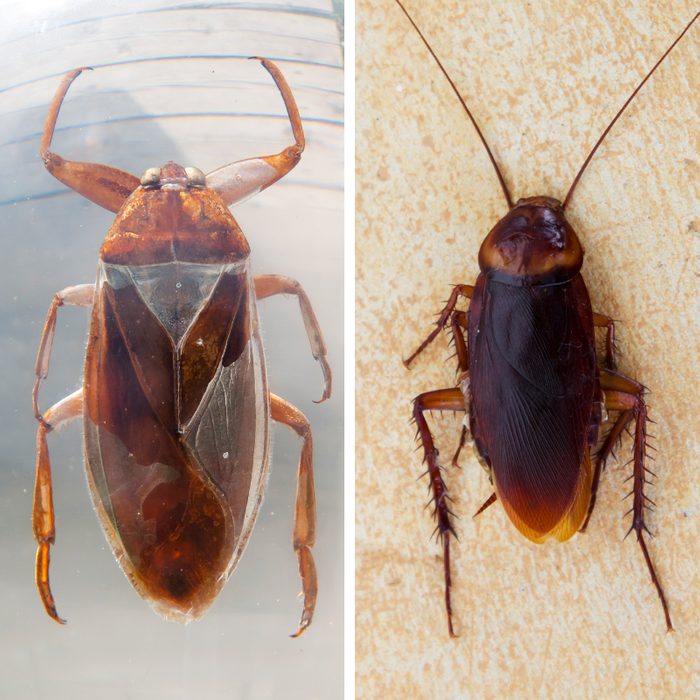Water Bugs vs. Cockroaches: What’s the Difference?
Updated: Apr. 10, 2023

Water bugs look like big cockroaches, but they're a completely different species. And they bite. Here's how to tell these two insects apart.
If, as a child, I knew what I know now about water bugs, I would have treated them with more respect.
These large insects populated a nearby creek my friends and I frequented. While we never tried to catch one, we never worried if one got too close. That was a mistake, because these insects can bite humans between their toes, and bite hard. Technically, it isn’t actually a bite but an injection of venom— but who’s going to worry about how it happened when the pain starts?
Water bugs belong to the family Belostomatidae, which includes some 150 species. For bugs, they’re big. Their oval-shaped bodies resemble American cockroaches, with similar coloring. Luckily, cockroaches and water bugs are easy to tell apart.
Habitat is one major difference. Water bugs are aquatic, as the name suggests, while most cockroaches avoid water. And while cockroaches forage for food in basements and pantries, water bugs are predators — they eat fish!
On This Page
Water Bugs vs. Cockroaches: What Do They Look Like?
Cockroaches and water bugs both have oval bodies and six legs, but water bugs are much larger. Cockroaches are typically about an inch long (some exotic species are larger), while water bugs can be two to four inches long with wider bodies. Both tend to be brown or black. Cockroaches’ coloring often includes tinges of red or tan, while water bugs tend more toward gray.
The most noticeable difference? Water bugs have no antennae. Their front legs may look like antennae, but they actually use them to catch prey. Cockroaches have compound eyes partially hidden by the head and thorax; water bug eyes look pretty normal.
Oriental cockroaches (Blatta orientalis) are the ones most likely to be mistaken for water bugs because they’re dark and live near water; sometimes they’re called water roaches. But unlike water bugs, Oriental cockroaches lack wings and can’t fly — a dead giveaway. Cockroaches make noise to communicate.
Water Bugs vs. Cockroaches: Where Do They Live?
Water bugs prefer ponds, marshes and slow-moving streams throughout North America. They can stay underwater for long periods because a tube on the abdomen extends above the surface, allowing them to breathe.
They’ll often float an inch or two below the surface, perfectly positioned for an unsuspecting wader to step on one and receive a painful bite. Hence, the nickname “toe-biters.” The venom isn’t deadly to humans, but the bites are painful.
All but the Oriental cockroach are terrestrial. They prefer dark, moist places to make nests and breed.
In the house, you may find cockroaches in the basement, under shelves, inside cabinets or in some other dark, damp place. Outdoors, they tend to nest under logs or inside woodpiles. They’re also present throughout North America, hibernating or seeking warmth inside buildings when it’s cold.
Water Bugs vs. Cockroaches: Behavior
Water bugs are also known as “electric light bugs.” When they fly from one body of water to another, they’re attracted by bright lights. If you hear a large insect buzzing around your porch light at night, there’s a good chance it’s a water bug.
When not buzzing around lights, they’re usually sitting motionless near the shore of a body of water or just under the surface, waiting to pounce. A water bug can feign death when approached by a larger predator and ooze an odorous liquid from its anus as a defense mechanism.
Cockroaches are highly social, unlike water bugs, which are solitary insects. If you see one roach, others are probably nearby. Cockroaches are most active at night, from a few hours before sunset to dawn, and they tend to congregate. If a space is too small, a colony will split and seek multiple nesting sites.
Water Bugs vs. Cockroaches: How To Get Rid of Them
Cockroaches like sweet stuff, so mixing sugar or honey with boric acid is one common way to poison them. Orange oil, insecticide spray and diatomaceous earth can also be used. But if it’s a large infestation, it’s usually best to call an exterminator.
When you see a water bug, it’s probably alone. If you see more than one, you’re probably looking at Oriental or American cockroaches, not water bugs. If you can catch a water bug in your home and release it outside, it will fly away, and you’ll probably never see it again. Just don’t handle it barehanded.
